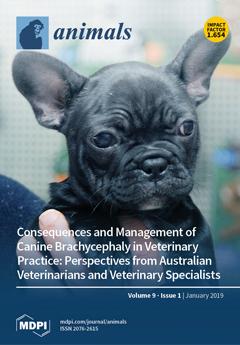Consequences and Management of Canine Brachycephaly in Veterinary Practice: Perspectives from Australian Veterinarians and Veterinary Specialists

Consequences and Management of Canine Brachycephaly in Veterinary Practice: Perspectives from Australian Veterinarians and Veterinary Specialists
Fawcett, et al., including Paul McGreevy, University of Sydney, Australia
Animals 2019, 9, 3; doi:10.3390/ani9010003
For: Veterinarians, health care professionals, all stakeholders
Review: Brenda Bonnett, DVM, PhD
This comprehensive review covers the health problems and welfare issues in brachycephalic dogs highlighting a veterinary perspective. The text of the paper comprises 19 pages and includes a wide-range of topics. This paper is an excellent resource for veterinary health care professionals and clinicians. However, topics in this paper are also important for all stakeholders involved with the brachycephalic issue in dogs. At the end of the paper, there is an important discussion of the ethical challenges for veterinarians, both as individuals and the profession as a whole. Concerned that readers, especially those who are not clinicians, may not persevere through the clinical information to reach this important section, I will highlight the importance of that discussion below. First, a general overview:
“Simple Summary: Canine and human co-evolution have disclosed remarkable morphological plasticity in dogs. Brachycephalic dog breeds are increasing in popularity, despite them suffering from well-documented conformation-related health problems. This has implications for the veterinary caseloads of the future. Whether the recent selection of dogs with progressively shorter and wider skulls has reached physiological limits is controversial. The health problems and short life expectancies of dogs with extremely short skulls suggests that we may have even exceeded these limits. Veterinarians have a professional and moral obligation to prevent and minimise the negative health and welfare impacts of extreme morphology and inherited disorders, and they must address brachycephalic obstructive airway syndrome (BOAS) not only at the level of the patient, but also as a systemic welfare problem.”
The broad range of topics include:
- · Concern that “Despite well-documented conformation-related health problems, brachycephalic dog breeds are increasing in popularity.”;
- · Detailed enumeration and description of associated health problems;
- · Behavioural impacts of brachycephaly, as well as
- · “substantial evidence that brachycephaly compromises the welfare of affected dogs”, highlighting insurance data and research findings;
- · Problems for individual dogs and their owners as well as for breed populations;
- · Immediate concerns as well as future perspectives;
- · Clinical diagnosis and management of BOAS and other problems in brachys, and
- · A thought provoking discussion of “Ethical Challenges Associated with Brachycephalic Breeds” and the role of veterinarians.
Understanding the Complexity – the veterinary perspective
Past all the discussion of clinical findings and approaches, the section on ethical challenges has excellent coverage of the concerns and conflicting interests for veterinarians. For example, the best resolution for competing issues is not always clear, e.g.:
- · the best interests of an individual dog, in general, and in relation to a specific health event;
- · its owner’s attachment, attitudes, wishes, needs, and ability to provide care; and
- · concerns for the breed overall, as well as
- · the practical reality of the veterinarian as both a caregiver and a business person.
Two of the authors have also provided this summary: “Vets can do more to reduce the suffering of flat-faced dog breeds”:
February 12, 2019 2.16pm EST
It is important for all stakeholders to be aware of the challenges facing others as the dog world moves toward doing is what is best for dogs.
Also see:
- DWN's Extremes of Conformation Category
- Latest on brachycephalics from Sweden
- Approaches to Breed-specific Extremes
 Donate
Donate
0 Comments
Recommended Comments
There are no comments to display.